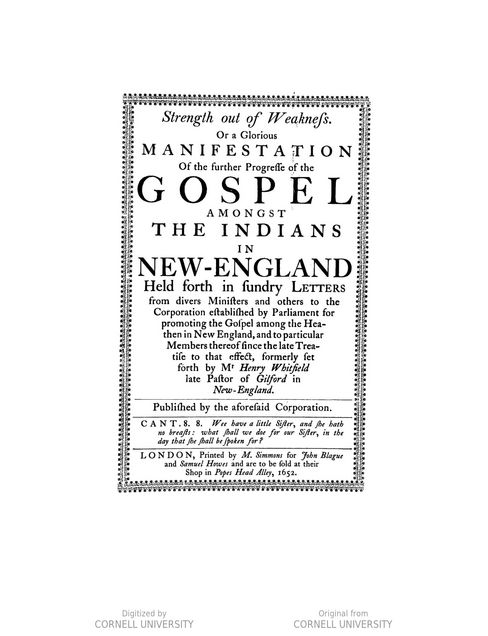John Eliot, et al., Strength out of weakness, Or, a glorious manifestation of the further progresse of the Gospel among the Indians in New England (London, 1652)

Sam Katz, Matthew Terlovsky, and Tina Zhang
This research paper is telling the story of, “Strength out of weakness, Or, a glorious manifestation of the further progresse of the Gospel among the Indians in New England (London, 1652)”, written by John Eliot and other important figures, and the stories of the people within the text. Furthermore, the paper discusses John Eliots’ and other key Christian figures’ views of Christianity in the sense of expansionism, attempting to show the perspectives of expansionism and the results, especially to the Indians in New England.
In the introduction, the paper introduces a synopsis of the text. To summarize, as the earliest intruders of America, a group of colonists from England came to America and brought their cultures and religions to the New World. With the development of praying towns by the New England Puritans, more Native American tribes were converted to Christianity. Puritans took a series of actions in the name of God to convert the indigenous people. Furthermore, in the process of Christianity expansionism, there are several aspects that should be considered as the final “success” of expansionism. What the reasons are for Christianity expansionism, how the puritans put their thoughts into practice, and what are the results of expansionism, especially to the Indians in New England. At the end of the introduction, the four sections of the research paper are discussed based on observations in the text, and similar ideas brought up by various articles and sources.
The first section is a short biography of John Eliot, John Wilson, William Leverich, Anthony Bessey, Thomas Mayhew, John Endecott, William French, and Thomas Allen. This would be where the story of the authors is told. However, it will mostly talk about John Eliot and the more important writers, considering they are more prominent in history. In addition, this section helps to describe the positions each author held in society to help explain why they are writing the letters in the first place, Furthermore, this section will include necessary numerical values including dates of publication, and will possibly analyze a small portion of each section or letter the different authors wrote in order to understand the authors’ motives further.
Next, in the second section of the paper, the function and use of the text itself is explained. It explains what the purpose of the piece is, who the letters were sent to, and why they were being sent. To try to put it in a single simple sentence, the second section of the paper delves into the analysis of the meanings behind the text and why the authors want to start the expansionism of Christianity. Additionally, while covering the purpose, it will be explained how the letters serve as check-ins to the Native Americans. In fact, the paper continues off of this point and brings up the next topic pertaining to the reasons for the expansion, including the power thirst and ethnocentrism of the authors and colonists.
Continuing, in section three, the various methods that the English used for expansionism will be talked about. This section discusses how the English were able to take control of the Native Americans with physical power and the “power of God”. Although the letters are meant to be used as check-ins, as mentioned before, they can also be seen as an instruction manual on how to expand into new territory, allowing one to see the effectiveness of different methods of expansionism.
Then, in the fourth and final section of the paper, the treatment and influence on Indians, and the continuation of influence on them is discussed. This section shifts the direction away from the English perspective, moving towards the story of the Native Americans, and the effects of expansionism to their society. Specifically, what the colonists made the Native Americans do during this time. For example, Indian Praying Towns show how expansionism plays an important role in the Native American history, and their relationship with the colonists, both positive and negative. Furthermore, the section continues with the profound, long lasting influence of the colonists’ actions, and how Native American culture nearly collapsed under Christian expansionism in the colonies.
Finally, the conclusion begins with the main points about the results of Christian expansionism, in terms of why and how it occurred, are summarized. Moreover, the discussion of why the research matters to begin with, restating the short/long term effects of expansionism on Native Americans and in America. The end of the conclusion is meant for the audience to form opinions on the methods which made America.